air condition HONDA ACCORD SEDAN 2001 (in English) User Guide
[x] Cancel search | Manufacturer: HONDA, Model Year: 2001, Model line: ACCORD SEDAN, Model: HONDA ACCORD SEDAN 2001Pages: 372, PDF Size: 6.1 MB
Page 161 of 372
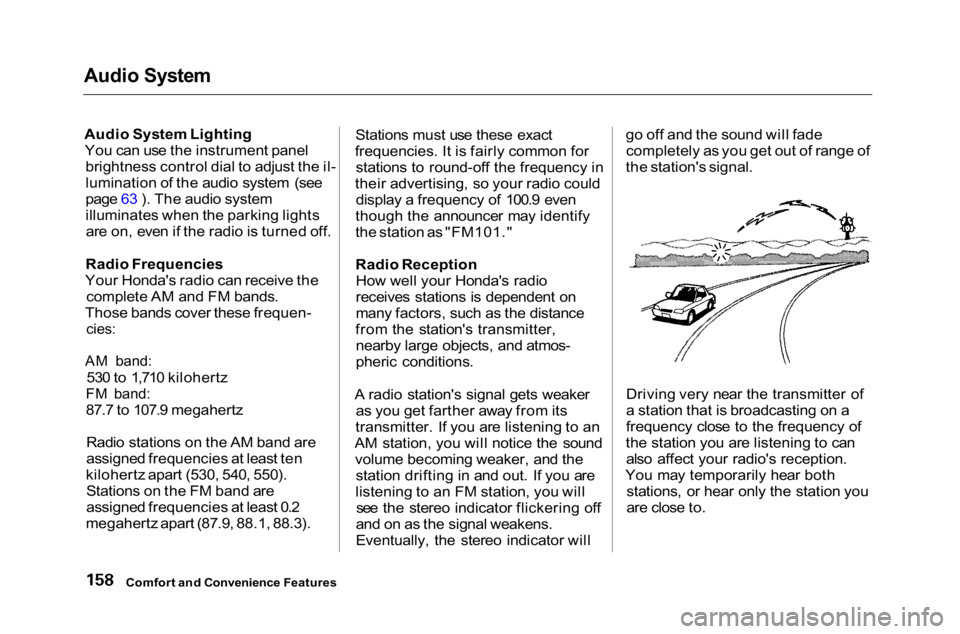
Audio System
Audio System LightingYou can use the instrument panel brightness control dial to adjust the il-
lumination of the audio system (see
page 63 ). The audio system
illuminates when the parking lightsare on, even if the radio is turned off.
Radio Frequencies
Your Honda's radio can receive the complete AM and FM bands.
Those bands cover these frequen-
cies:
AM band:
530 to 1,710 kilohertz
FM band:
87.7 to 107.9 megahertz
Radio stations on the AM band are
assigned frequencies at least ten
kilohertz apart (530, 540, 550). Stations on the FM band are
assigned frequencies at least 0.2
megahertz apart (87.9, 88.1, 88.3). Stations must use these exact
frequencies. It is fairly common for stations to round-off the frequency in
their advertising, so your radio could display a frequency of 100.9 even
though the announcer may identify
the station as "FM101."
Radio Reception How well your Honda's radio
receives stations is dependent on
many factors, such as the distance
from the station's transmitter, nearby large objects, and atmos-
pheric conditions.
A radio station's signal gets weaker as you get farther away from its
transmitter. If you are listening to an
AM station, you will notice the sound volume becoming weaker, and the station drifting in and out. If you are
listening to an FM station, you will see the stereo indicator flickering off
and on as the signal weakens.
Eventually, the stereo indicator will go off and the sound will fade
completely as you get out of range of
the station's signal.
Driving very near the transmitter of
a station that is broadcasting on a
frequency close to the frequency of
the station you are listening to can also affect your radio's reception.
You may temporarily hear both stations, or hear only the station you
are close to.
Comfort and Convenience Features
Page 188 of 372
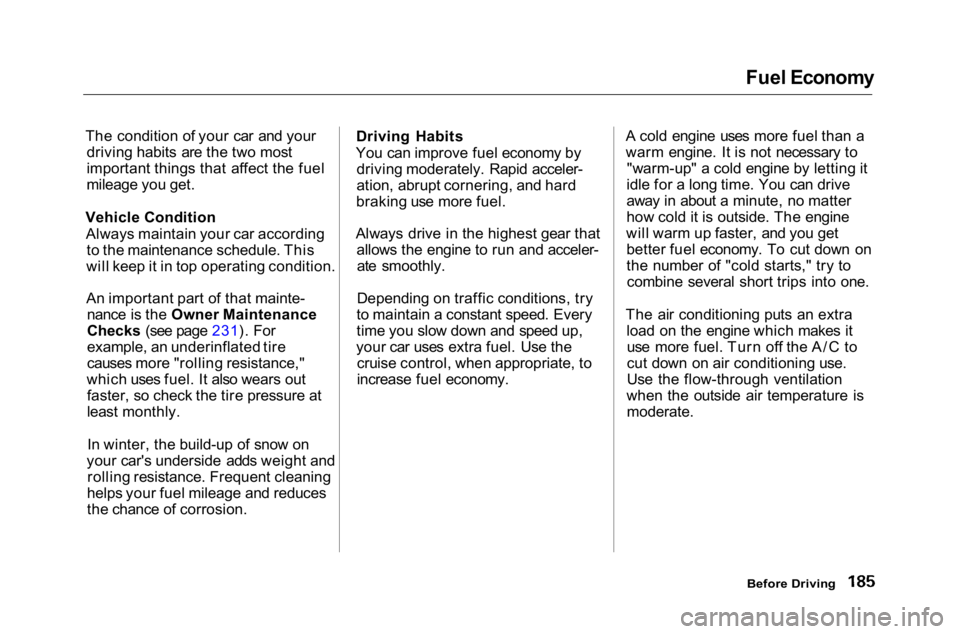
Fuel Economy
The condition of your car and your driving habits are the two most
important things that affect the fuel
mileage you get.
Vehicle Condition Always maintain your car according to the maintenance schedule. This
will keep it in top operating condition.
An important part of that mainte- nance is the Owner Maintenance
Checks (see page 231). For
example, an underinflated tire
causes more "rolling resistance,"
which uses fuel. It also wears out faster, so check the tire pressure at
least monthly.
In winter, the build-up of snow on
your car's underside adds weight and rolling resistance. Frequent cleaning
helps your fuel mileage and reduces
the chance of corrosion. Driving Habits
You can improve fuel economy by driving moderately. Rapid acceler-
ation, abrupt cornering, and hard
braking use more fuel.
Always drive in the highest gear that allows the engine to run and acceler-ate smoothly.
Depending on traffic conditions, try
to maintain a constant speed. Every
time you slow down and speed up,
your car uses extra fuel. Use the cruise control, when appropriate, to
increase fuel economy. A cold engine uses more fuel than a
warm engine. It is not necessary to
"warm-up" a cold engine by letting it
idle for a long time. You can drive
away in about a minute, no matter
how cold it is outside. The engine
will warm up faster, and you get better fuel economy. To cut down on
the number of "cold starts," try tocombine several short trips into one.
The air conditioning puts an extra load on the engine which makes ituse more fuel. Turn off the A/C to
cut down on air conditioning use.
Use the flow-through ventilation
when the outside air temperature is moderate.
Before Driving
Page 213 of 372
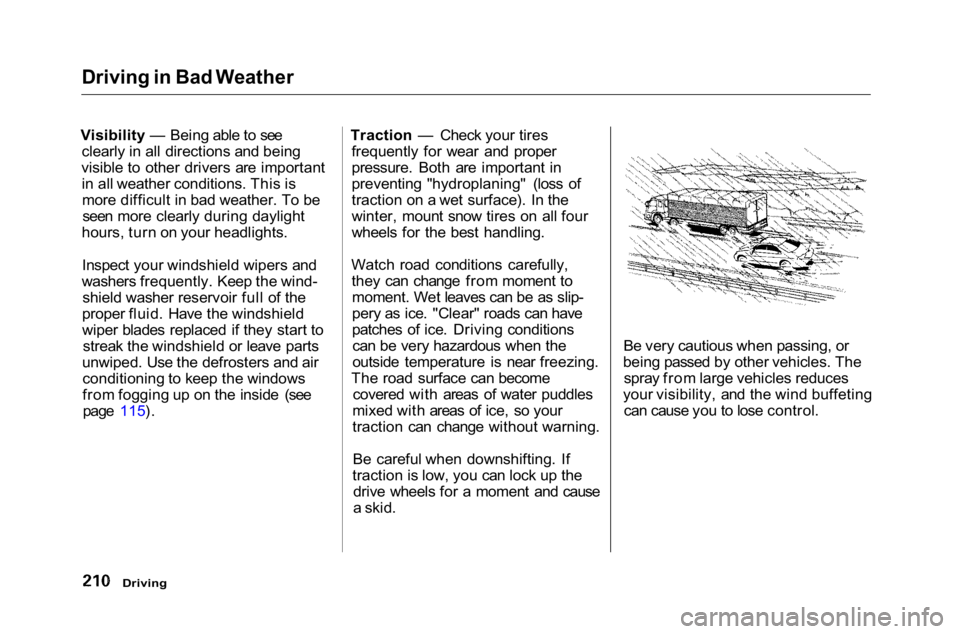
Driving in Bad Weather
Visibility — Being able to see clearly in all directions and being
visible to other drivers are important in all weather conditions. This ismore difficult in bad weather. To beseen more clearly during daylight
hours, turn on your headlights.
Inspect your windshield wipers and
washers frequently. Keep the wind- shield washer reservoir full of the
proper fluid. Have the windshield
wiper blades replaced if they start to streak the windshield or leave parts
unwiped. Use the defrosters and air conditioning to keep the windows
from fogging up on the inside (seepage 115). Traction — Check your tires
frequently for wear and proper
pressure. Both are important in
preventing "hydroplaning" (loss of
traction on a wet surface). In the
winter, mount snow tires on all four
wheels for the best handling.
Watch road conditions carefully, they can change from moment tomoment. Wet leaves can be as slip-
pery as ice. "Clear" roads can have
patches of ice. Driving conditionscan be very hazardous when the
outside temperature is near freezing.
The road surface can become covered with areas of water puddles
mixed with areas of ice, so your
traction can change without warning.
Be careful when downshifting. If
traction is low, you can lock up the drive wheels for a moment and cause
a skid. Be very cautious when passing, or
being passed by other vehicles. The spray from large vehicles reduces
your visibility, and the wind buffeting can cause you to lose control.
Driving
Page 219 of 372
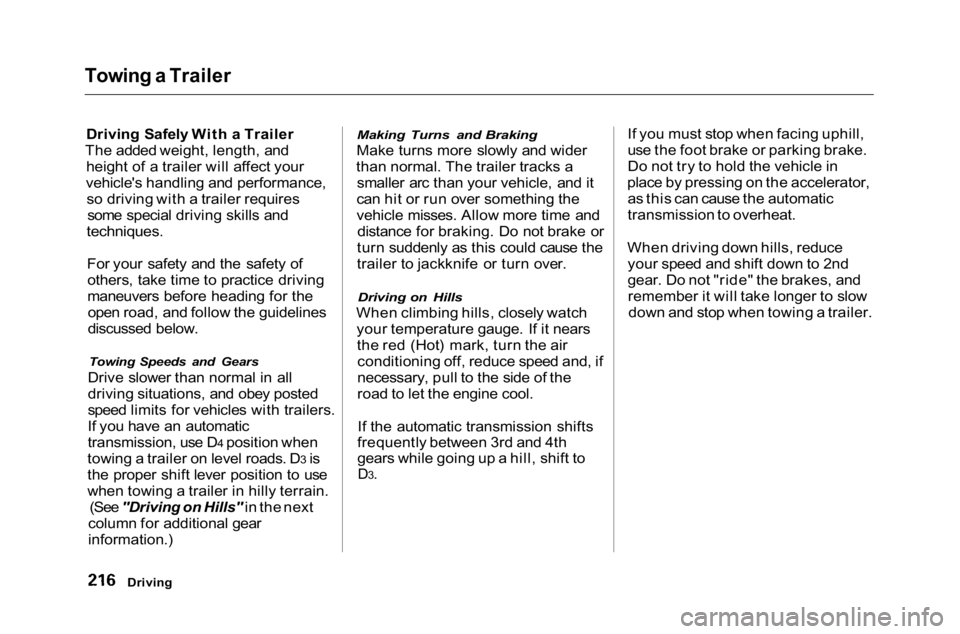
Towing a Trailer
Driving Safely With a Trailer
The added weight, length, and height of a trailer will affect your
vehicle's handling and performance, so driving with a trailer requiressome special driving skills and
techniques.
For your safety and the safety ofothers, take time to practice driving
maneuvers before heading for theopen road, and follow the guidelines
discussed below.
Towing Speeds and Gears
Drive slower than normal in all
driving situations, and obey posted
speed limits for vehicles with trailers.
If you have an automatic
transmission, use D4 position when
towing a trailer on level roads. D3 is
the proper shift lever position to use
when towing a trailer in hilly terrain. (See "Driving on Hills" in the next
column for additional gear
information.)
Making Turns and Braking
Make turns more slowly and wider
than normal. The trailer tracks a smaller arc than your vehicle, and it
can hit or run over something the
vehicle misses. Allow more time and distance for braking. Do not brake or
turn suddenly as this could cause the
trailer to jackknife or turn over.
Driving on Hills
When climbing hills, closely watch your temperature gauge. If it nearsthe red (Hot) mark, turn the airconditioning off, reduce speed and, if
necessary, pull to the side of the
road to let the engine cool.
If the automatic transmission shifts
frequently between 3rd and 4th
gears while going up a hill, shift to
D3.
If you must stop when facing uphill,
use the foot brake or parking brake.
Do not try to hold the vehicle in
place by pressing on the accelerator, as this can cause the automatic
transmission to overheat.
When driving down hills, reduce your speed and shift down to 2nd
gear. Do not "ride" the brakes, andremember it will take longer to slowdown and stop when towing a trailer.
Driving
Page 222 of 372
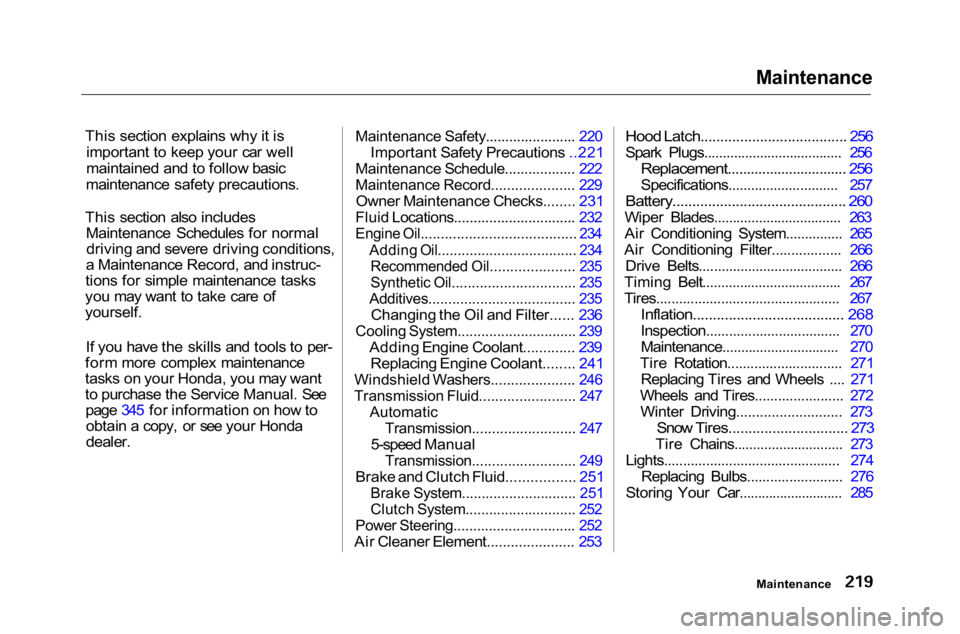
Maintenance
This section explains why it is important to keep your car well
maintained and to follow basic
maintenance safety precautions.
This section also includes Maintenance Schedules for normaldriving and severe driving conditions,
a Maintenance Record, and instruc-
tions for simple maintenance tasks
you may want to take care of
yourself.
If you have the skills and tools to per-
form more complex maintenance
tasks on your Honda, you may want
to purchase the Service Manual. See page 345 for information on how toobtain a copy, or see your Honda
dealer.
Maintenance Safety....................... 220
Important Safety Precautions ..221
Maintenance Schedule.................. 222
Maintenance Record..................... 229
Owner Maintenance Checks........ 231
Fluid Locations............................... 232
Engine Oil....................................... 234
Adding Oil................................... 234Recommended Oil..................... 235
Synthetic Oil............................... 235
Additives..................................... 235
Changing the Oil and Filter...... 236
Cooling System.............................. 239
Adding Engine Coolant............. 239Replacing Engine Coolant........ 241
Windshield Washers..................... 246
Transmission Fluid........................ 247
Automatic
Transmission.......................... 247
5-speed Manual
Transmission.......................... 249
Brake and Clutch Fluid................. 251
Brake System............................. 251
Clutch System............................ 252
Power Steering............................... 252
Air Cleaner Element...................... 253
Hood Latch..................................... 256
Spark Plugs..................................... 256
Replacement............................... 256
Specifications............................. 257
Battery............................................ 260
Wiper Blades.................................. 263
Air Conditioning System............... 265
Air Conditioning Filter.................. 266 Drive Belts...................................... 266
Timing Belt..................................... 267
Tires................................................ 267
Inflation...................................... 268
Inspection................................... 270
Maintenance............................... 270
Tire Rotation.............................. 271 Replacing Tires and Wheels .... 271
Wheels and Tires....................... 272 Winter Driving........................... 273
Snow Tires.............................. 273
Tire Chains............................. 273
Lights.............................................. 274 Replacing Bulbs......................... 276
Storing Your Car............................ 285
Maintenance
Page 229 of 372
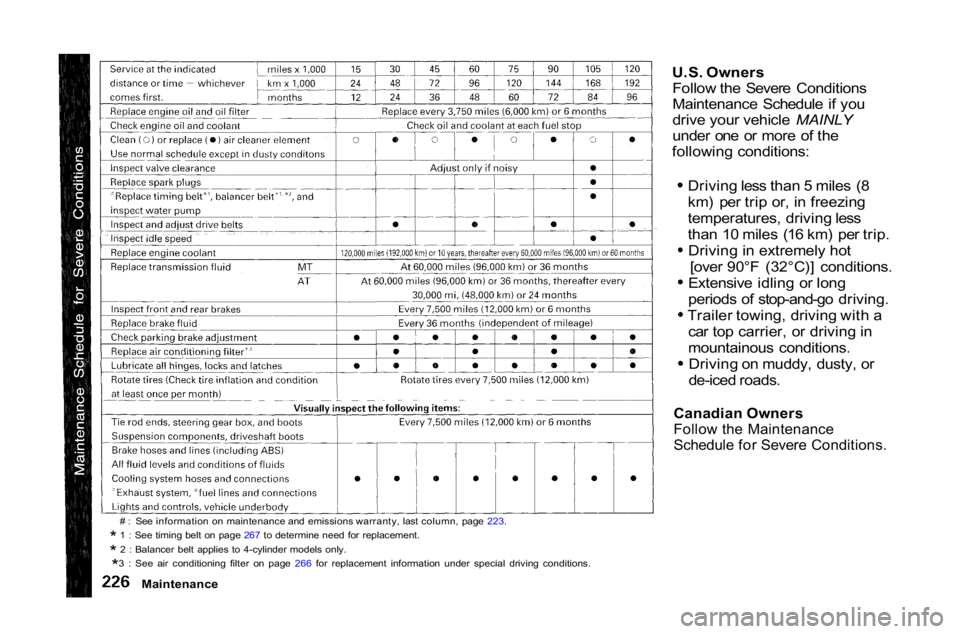
U.S. Owners
Follow the Severe Conditions
Maintenance Schedule if you
drive your vehicle MAINLY
under one or more of the
following conditions:
Driving less than 5 miles (8
km) per trip or, in freezing
temperatures, driving less
than 10 miles (16 km) per trip.Driving in extremely hot [over 90°F (32°C)] conditions.
Extensive idling or long
periods of stop-and-go driving.
Trailer towing, driving with a car top carrier, or driving in
mountainous conditions.Driving on muddy, dusty, or
de-iced roads.
Canadian Owners
Follow the Maintenance
Schedule for Severe Conditions.
# : See information on maintenance and emissions warranty, last column, page 223.
* 1 : See timing belt on page 267 to determine need for replacement.
* 2 : Balancer belt applies to 4-cylinder models only.
*3 : See air conditioning filter on page 266 for replacement information under special driving conditions.
Maintenance
Page 231 of 372
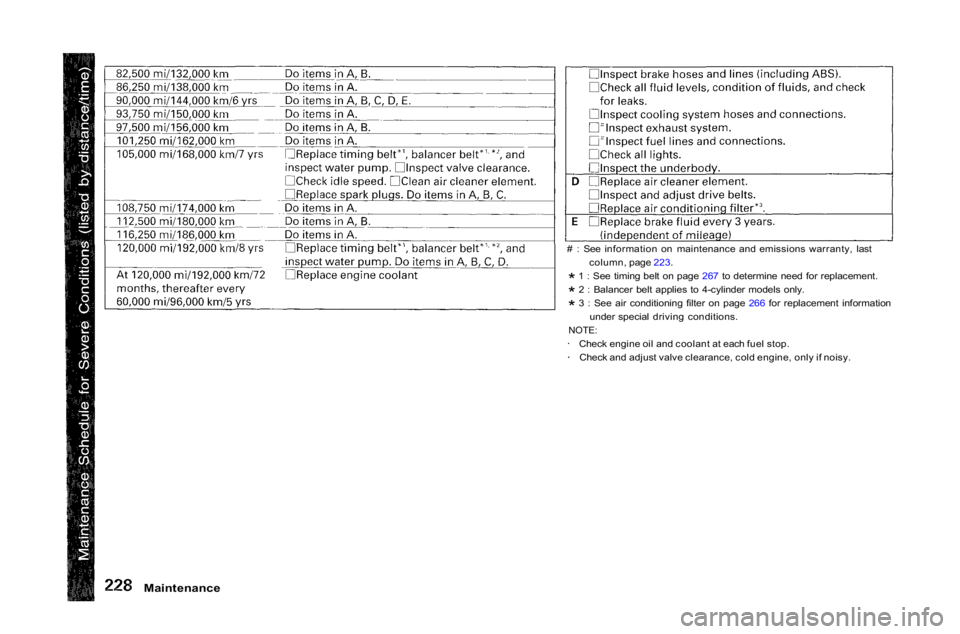
Maintenance
# : See information on maintenance and emissions warranty, last
column, page 223.
* 1 : See timing belt on page 267 to determine need for replacement.
* 2 : Balancer belt applies to 4-cylinder models only.
* 3 : See air conditioning filter on page 266 for replacement information
under special driving conditions.
NOTE:
Check engine oil and coolant at each fuel stop.
Check and adjust valve clearance, cold engine, only if noisy.
Page 256 of 372
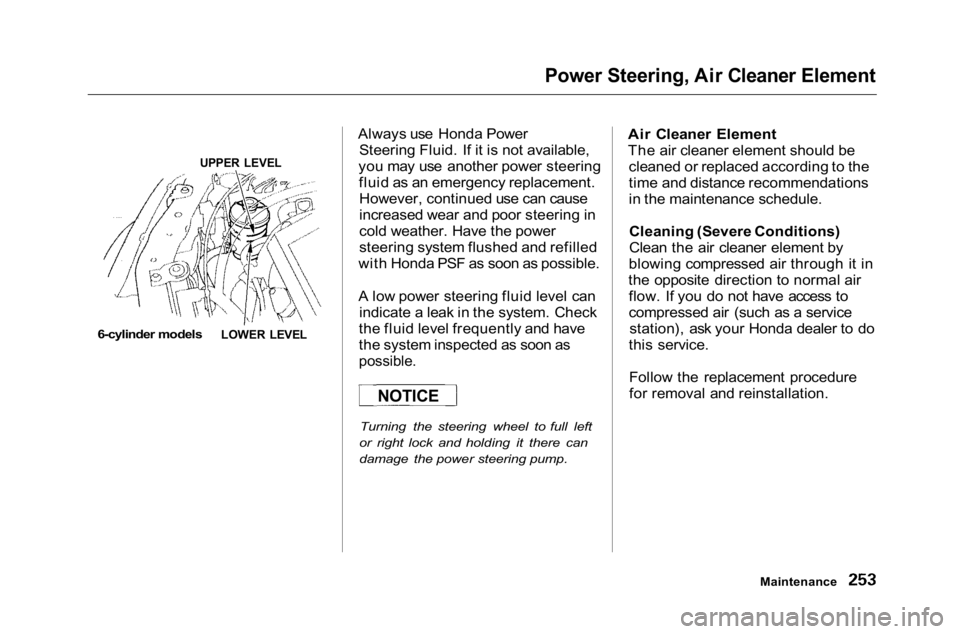
Power Steering, Air Cleaner Element
UPPER LEVEL
6-cylinder models
Always use Honda Power
Steering Fluid. If it is not available,
you may use another power steering fluid as an emergency replacement.However, continued use can cause
increased wear and poor steering in
cold weather. Have the power
steering system flushed and refilled
with Honda PSF as soon as possible.
A low power steering fluid level can indicate a leak in the system. Check
the fluid level frequently and have
the system inspected as soon as
possible.
Turning the steering wheel to full left
or right lock and holding it there can
damage the power steering pump.
Air Cleaner Element
The air cleaner element should be
cleaned or replaced according to the
time and distance recommendations
in the maintenance schedule.
Cleaning (Severe Conditions)
Clean the air cleaner element by
blowing compressed air through it in
the opposite direction to normal air flow. If you do not have access to
compressed air (such as a service station), ask your Honda dealer to do
this service.
Follow the replacement procedure
for removal and reinstallation.
Maintenance
NOTICE
LOWER LEVEL
Page 268 of 372
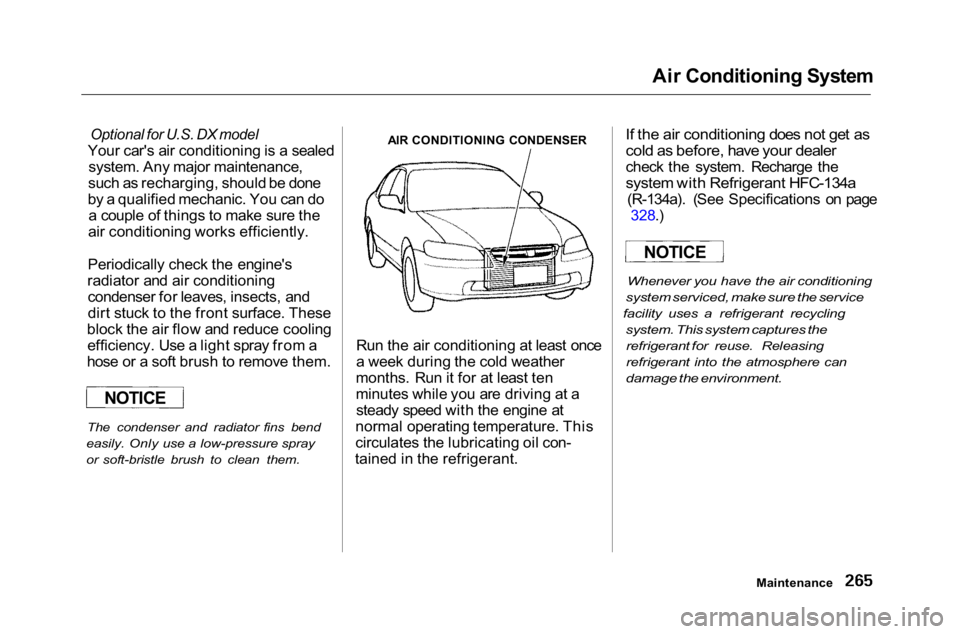
Air Conditioning System
Optional for U.S. DX model
Your car's air conditioning is a sealed system. Any major maintenance,
such as recharging, should be done
by a qualified mechanic. You can do a couple of things to make sure the
air conditioning works efficiently.
Periodically check the engine's
radiator and air conditioning condenser for leaves, insects, and
dirt stuck to the front surface. These
block the air flow and reduce cooling efficiency. Use a light spray from a
hose or a soft brush to remove them.
The condenser and radiator fins bend
easily. Only use a low-pressure spray
or soft-bristle brush to clean them.
AIR CONDITIONING CONDENSER
Run the air conditioning at least once
a week during the cold weather
months. Run it for at least ten
minutes while you are driving at a steady speed with the engine at
normal operating temperature. This
circulates the lubricating oil con-
tained in the refrigerant.
If the air conditioning does not get as
cold as before, have your dealer
check the system. Recharge the
system with Refrigerant HFC-134a
(R-134a). (See Specifications on page 328.)
Whenever you have the air conditioning
system serviced, make sure the service
facility uses a refrigerant recycling
system. This system captures the
refrigerant for reuse. Releasing
refrigerant into the atmosphere can
damage the environment.
Maintenance
NOTICE
NOTICE
Page 269 of 372
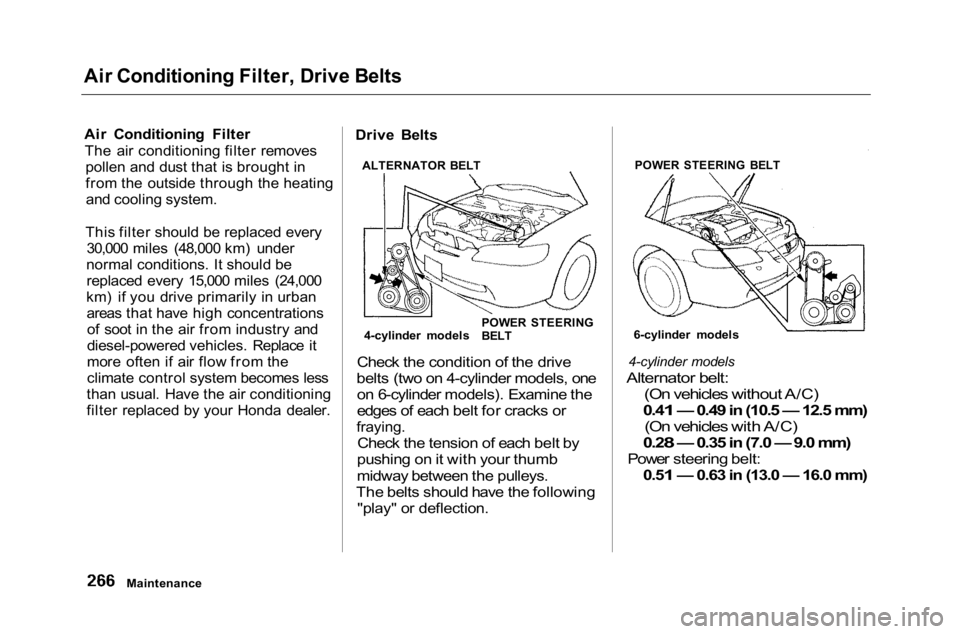
Air Conditioning Filter, Drive Belts
Air Conditioning FilterThe air conditioning filter removes pollen and dust that is brought in
from the outside through the heatingand cooling system.
This filter should be replaced every 30,000 miles (48,000 km) under
normal conditions. It should be replaced every 15,000 miles (24,000
km) if you drive primarily in urban areas that have high concentrationsof soot in the air from industry and
diesel-powered vehicles. Replace it
more often if air flow from the
climate control system becomes less
than usual. Have the air conditioning
filter replaced by your Honda dealer. Drive Belts
Check the condition of the drive
belts (two on 4-cylinder models, one
on 6-cylinder models). Examine the
edges of each belt for cracks or
fraying.
Check the tension of each belt by
pushing on it with your thumb
midway between the pulleys.
The belts should have the following
"play" or deflection.
4-cylinder models
Alternator belt: (On vehicles without A/C)
0.41 — 0.49 in (10.5 — 12.5 mm)
(On vehicles with A/C)
0.28 — 0.35 in (7.0 — 9.0 mm)
Power steering belt:
0.51 — 0.63 in (13.0 — 16.0 mm)
Maintenance
ALTERNATOR BELT
4-cylinder models
POWER STEERING
BELT
6-cylinder models
POWER STEERING BELT